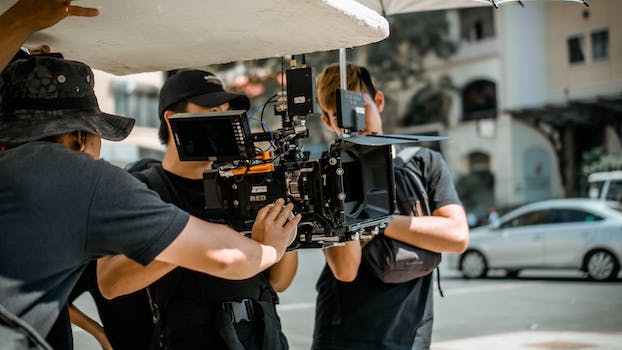Dramatic films have the power to captivate and move audiences like no other form of entertainment. However, not all films are created equal, and not all of them achieve the level of excellence that audiences crave. This is where the art of critiquing comes in. In this comprehensive guide, we will explore the various elements that make up a great dramatic film, and provide you with the tools to evaluate these elements objectively and effectively. Whether you are a film student, a professional critic, or simply a lover of great cinema, this guide will help you appreciate and analyze dramatic films like never before.
- 1. The Art of Dramatic Film Critiques
- 1.1. Understanding the Elements of a Dramatic Film
- 1.2. Analyzing the Plot and Character Development
- 1.3. Evaluating the Cinematography and Sound Design
- 1.4. Assessing the Acting Performances
- 1.5. Identifying the Theme and Message of the Film
- 2. The Importance of Context in Film Criticism
- 2.1. Considering the Historical and Cultural Context
- 2.2. Examining the Director’s Body of Work
- 2.3. Relating the Film to Current Social Issues
- 2.4. Acknowledging the Audience’s Perspective
- 2.5. Recognizing the Influence of Other Critics
- 3. Effective Writing Techniques for Film Critiques
1. The Art of Dramatic Film Critiques
Dramatic films are often the most emotionally charged and thought-provoking movies. As a film critic, it is important to understand the art of critiquing dramatic films in order to provide insightful and valuable feedback to readers. The key to a successful critique of a dramatic film is to analyze and evaluate the storytelling, character development, and emotional impact. A good critic should aim to provide a balanced and well-rounded critique that takes into account both the strengths and weaknesses of the film. By mastering the art of critiquing dramatic films, a critic can help their readers to better understand and appreciate the power of cinema.
1.1. Understanding the Elements of a Dramatic Film
Understanding the elements of a dramatic film is crucial for anyone who wants to develop their skills in critiquing movies. While there are many different elements that can contribute to the success of a dramatic film, there are a few key factors that are particularly important to keep in mind. These include the plot, the characters, the setting, the themes, and the overall tone of the film. By paying close attention to these elements and analyzing how they work together, you can gain a deeper understanding of what makes a dramatic film successful and how to effectively critique it.
1.2. Analyzing the Plot and Character Development
When critiquing a dramatic film, it is important to analyze both the plot and the development of the characters. The plot should have a clear beginning, middle, and end, with a well-defined conflict and resolution. The characters should be fully developed with clear motivations and believable actions that drive the plot forward. Analyzing both the plot and character development can help the critic to understand the deeper themes and messages of the film, as well as evaluate the effectiveness of the storytelling and acting.
1.3. Evaluating the Cinematography and Sound Design
When it comes to evaluating dramatic films, two important elements to consider are cinematography and sound design. Cinematography refers to the visual aspects of the film, such as lighting, camera angles, and composition, while sound design encompasses all aspects of sound in the film, including dialogue, music, and sound effects. Together, these elements can greatly impact the emotional impact and overall effectiveness of a dramatic film. In this section, we will explore how to evaluate the cinematography and sound design of a dramatic film in detail.
1.4. Assessing the Acting Performances
Assessing the acting performances in a dramatic film is a crucial element of a comprehensive critique. It is important to evaluate not only the technical aspects of the performances such as delivery and timing, but also the emotional depth and range of each actor. A skilled actor can convey a range of emotions and create a complex character that draws the audience in. It is also important to consider the chemistry between actors and how well they work together on screen. Ultimately, the success of a dramatic film often depends on the strength of the acting performances.
1.5. Identifying the Theme and Message of the Film
Identifying the theme and message of a film is an essential part of writing a successful dramatic film critique. The theme is the underlying message or meaning of the film, and the message is the specific point or idea that the filmmaker is trying to communicate. To identify the theme and message of a film, it is important to analyze the story, characters, and overall tone of the movie. This can help you understand the filmmaker’s intentions and the larger ideas that the film is exploring. Once you have identified the theme and message of the movie, you can use this information to craft a thoughtful and insightful critique that engages with the film on a deeper level.
2. The Importance of Context in Film Criticism
Context is an essential factor in film criticism. Without considering the context in which a film was made, it is impossible to fully understand and appreciate its significance. For example, a film that was made during a particular political or social climate may have been influenced by those factors and may have a deeper meaning that can only be understood by taking those elements into account. Additionally, understanding the context in which a film was made can help to shed light on the filmmaker’s intentions and the choices they made in the production of the film. Overall, context is an integral part of film criticism and should always be considered when analyzing and critiquing dramatic films.
2.1. Considering the Historical and Cultural Context
When critiquing dramatic films, it is important to consider the historical and cultural context in which the film was created. The beliefs, values, and social norms of a particular time period can greatly influence the themes and messages portrayed in a film. For example, a film created during the height of the Civil Rights Movement in the United States may have a very different perspective on race relations than a film created in the present day. By understanding the historical and cultural context of a film, a critic can better analyze its meaning and significance. This is especially important when critiquing films from different cultures or time periods, as what may be viewed as acceptable or taboo in one society may not be the same in another.
2.2. Examining the Director’s Body of Work
When examining a director’s body of work, it is important to consider the context in which their films were made. This includes factors such as the time period, cultural climate, and personal experiences of the director. Without taking these elements into account, it is impossible to fully understand and appreciate a film. For example, a movie made in the 1940s will have different themes and cinematic techniques than one made in the 1980s. Similarly, a director who grew up during a particular era may incorporate their own experiences and perspectives into their work. By examining the context surrounding a film, a critic can better evaluate its artistic merit and cultural significance.
2.4. Acknowledging the Audience’s Perspective
It is important for film critics to acknowledge the audience’s perspective when critiquing dramatic films. After all, films are made to be seen by audiences and their reactions can greatly impact a film’s success. By considering the audience’s perspective, critics can better understand how a film may be received by the public and provide a more accurate assessment. Additionally, acknowledging the audience’s perspective can help critics avoid being overly biased or elitist in their critiques, making their reviews more accessible to a wider range of readers.
2.5. Recognizing the Influence of Other Critics
When it comes to film criticism, it’s important to recognize the influence of other critics. Whether it’s through reading reviews or discussing films with fellow critics, being aware of other perspectives can help expand your own understanding of a particular film or genre. However, it’s also important to maintain your own unique voice and not simply regurgitate the opinions of others. Context is key in film criticism, as every film exists within a particular cultural and historical moment. Understanding the context in which a film was made and how it was received by audiences and critics at the time can provide valuable insight into its meaning and cultural significance. Ultimately, a good film critic is able to balance their own perspective with an awareness of the larger critical conversation surrounding a particular film.
3. Effective Writing Techniques for Film Critiques
Effective writing techniques are essential for crafting well-written and insightful film critiques. One of the most important techniques is to begin with a strong and attention-grabbing introduction that hooks the reader and sets the tone for the rest of the critique. Another valuable technique is to provide specific examples from the film to support your opinions and analysis. It is also important to be clear and concise in your writing, avoiding unnecessary repetition or tangents. Additionally, using descriptive language and vivid imagery can help to paint a clear picture of the film for the reader. Finally, a strong conclusion that summarizes your main points and leaves a lasting impression on the reader can make all the difference in a successful film critique.
3.1. Crafting an Engaging Introduction
Crafting an engaging introduction is crucial to catch the reader’s attention and keep them interested in your film critique. A great introduction should be concise, clear, and intriguing, providing a brief overview of the film and your overall impression of it. Consider using a quote, a surprising fact, or a thought-provoking question to hook your reader. Additionally, make sure to avoid spoilers and give the reader a reason to continue reading your critique.
3.2. Using Specific Examples to Support Your Analysis
One effective writing technique for film critiques is to use specific examples to support your analysis. Instead of simply stating your opinion on a particular aspect of the film, such as the acting or cinematography, provide specific examples from the film that illustrate your point. For example, if you are critiquing the acting, mention specific scenes or moments in the film where you felt the actors were particularly convincing or unconvincing. This not only adds credibility to your critique, but also helps the reader understand exactly what you are referring to and why you have formed your opinion.
3.3. Employing Vivid Descriptions and Metaphors
Effective film critiques require the use of vivid descriptions and metaphors that engage the reader’s senses and imagination. By employing descriptive language, the writer can create a more immersive experience for the reader, allowing them to visualize the scenes and characters in their minds. Metaphors can also be used to convey complex ideas or emotions in a concise and impactful way. For example, a critic might describe a film as a ‘rollercoaster ride of emotions’ or a ‘visual feast for the eyes’. These types of descriptive phrases can help the reader understand the writer’s perspective and enhance their enjoyment of the film.
3.4. Maintaining a Clear and Logical Structure
Maintaining a clear and logical structure is essential when writing effective film critiques. This involves organizing your thoughts and ideas in a way that is easy for the reader to follow. One effective technique is to start with a clear introduction that provides an overview of the film and your overall opinion. From there, you can move on to discussing specific aspects of the film, such as the plot, characters, and cinematography. It is important to use clear and concise language, and to provide specific examples to support your arguments. Finally, you should wrap up your critique with a clear conclusion that summarizes your main points and provides a final evaluation of the film.
3.5. Concluding with a Thoughtful and Memorable Statement
In conclusion, effective writing techniques for film critiques involve a combination of analytical skills, creative writing, and a deep understanding of the art of filmmaking. By following the guidelines presented in this guide, aspiring film critics can hone their craft and produce thoughtful and memorable reviews that engage and enlighten their readers. Remember, a great film critique is not just a summary of the plot, but a reflection of the filmmaker’s vision and the impact of the film on its audience. So, go ahead and unleash your creativity, and let your passion for cinema shine through in your writing!
Conclusion
In conclusion, critiquing dramatic films requires a combination of knowledge, skill, and personal experience. By following the comprehensive guide outlined in this article, aspiring film critics can develop their own unique perspective and approach to evaluating movies. With practice and dedication, anyone can become a proficient and insightful critic.





